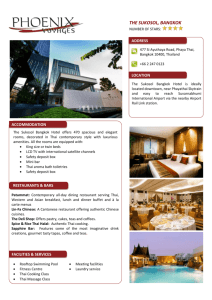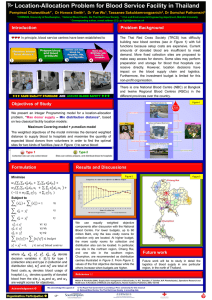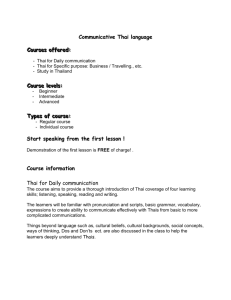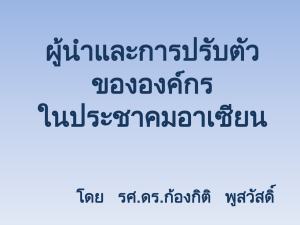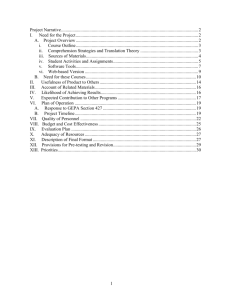Teaching Resources
advertisement
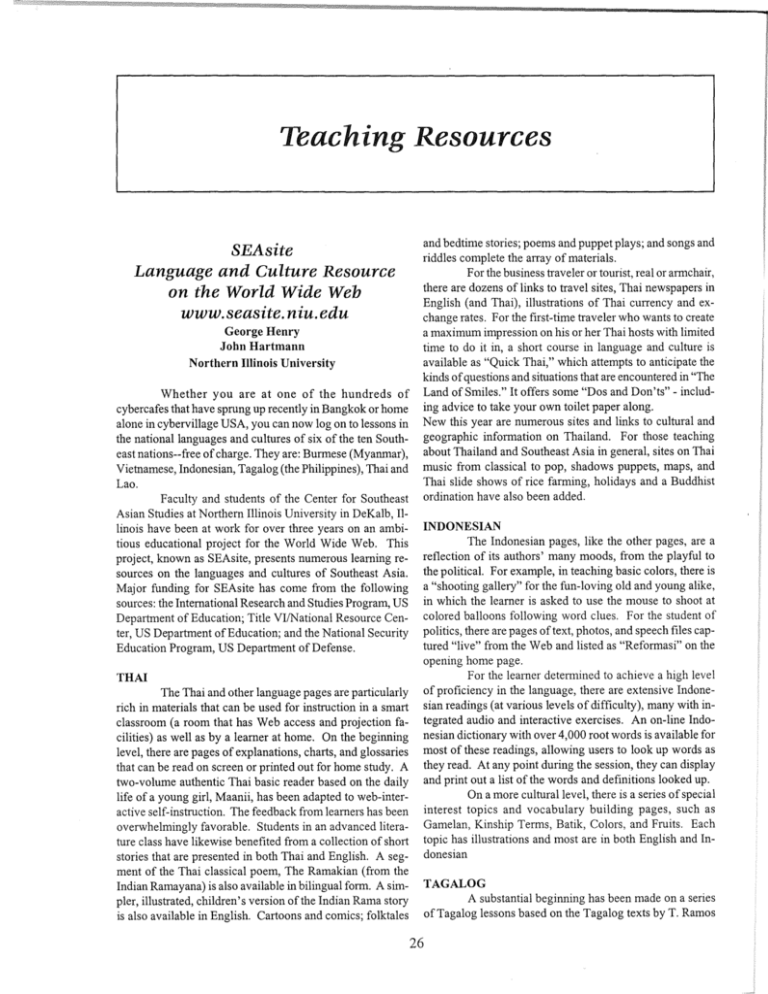
Teaching Resources SEAsite Language and Culture Resource on the World Wide Web www. seasite. niu. edu George Henry John Hartmann Northern Illinois University Whether you are at one of the hundreds of cybercafes that have sprung up recently in Bangkok or home alone in cybervillage USA, you can now log on to lessons in the national languages and cultures of six of the ten Southeast nations--free of charge. They are: Burmese (Myanmar), Vietnamese, Indonesian, Tagalog (the Philippines), Thai and Lao. Faculty and students of the Center for Southeast Asian Studies at Northern Illinois University in DeKalb, Illinois have been at work for over three years on an ambitious educational project for the World Wide Web. This project, known as SEAsite, presents numerous learning resources on the languages and cultures of Southeast Asia. Major funding for SEAsite has come from the following sources: the International Research and Studies Program, US Department of Education; Title VI/National Resource Center, US Department of Education; and the National Security Education Program, US Department of Defense. THAI The Thai and other language pages are particularly rich in materials that can be used for instruction in a smart classroom (a room that has Web access and projection facilities) as well as by a learner at home. On the beginning level, there are pages of explanations, charts, and glossaries that can be read on screen or printed out for home study. A two-volume authentic Thai basic reader based on the daily life of a young girl, Maanii, has been adapted to web-interactive self-instruction. The feedback from learners has been overwhelmingly favorable. Students in an advanced literature class have likewise benefited from a collection of short stories that are presented in both Thai and English. A segment of the Thai classical poem, The Ramakian (from the Indian Ramayana) is also available in bilingual form. A simpler, illustrated, children's version of the Indian Rama story is also available in English. Cartoons and comics; folktales and bedtime stories; poems and puppet plays; and songs and riddles complete the array of materials. For the business traveler or tourist, real or armchair, there are dozens of links to travel sites, Thai newspapers in English (and Thai), illustrations of Thai currency and exchange rates. For the first-time traveler who wants to create a maximum impression on his or her Thai hosts with limited time to do it in, a short course in language and culture is available as "Quick Thai," which attempts to anticipate the kinds of questions and situations that are encountered in "The Land of Smiles." It offers some "Dos and Don'ts"- including advice to take your own toilet paper along. New this year are numerous sites and links to cultural and geographic information on Thailand. For those teaching about Thailand and Southeast Asia in general, sites on Thai music from classical to pop, shadows puppets, maps, and Thai slide shows of rice farming, holidays and a Buddhist ordination have also been added. INDONESIAN The Indonesian pages, like the other pages, are a reflection of its authors' many moods, from the playful to the political. For example, in teaching basic colors, there is a "shooting gallery" for the fun-loving old and young alike, in which the learner is asked to use the mouse to shoot at colored balloons following word clues. For the student of politics, there are pages of text, photos, and speech files captured "live" from the Web and listed as "Reformasi" on the opening home page. For the learner determined to achieve a high level of proficiency in the language, there are extensive Indonesian readings (at various levels of difficulty), many with integrated audio and interactive exercises. An on-line Indonesian dictionary with over 4,000 root words is available for most of these readings, allowing users to look up words as they read. At any point during the session, they can display and print out a list of the words and definitions looked up. On a more cultural level, there is a series of special interest topics and vocabulary building pages, such as Gamelan, Kinship Terms, Batik, Colors, and Fruits. Each topic has illustrations and most are in both English and Indonesian TAGALOG A substantial beginning has been made on a series of Tagalog lessons based on the Tagalog texts by T. Ramos 26 (University of Hawai'i). These lessons are based around "themes" which are developed through dialogs and other activities and are supplemented by a set of Web pages explaining in detail the intricacies of Tagalog grammar. Audio and interactive exercises have been added. Tagalog, like the Thai and Indonesian pages, also has a specific section for travelers and business people. In addition, the first edition of an interactive dictionary, similar to that for Indonesian, is available. Both the Indonesian and Tagalog dictionaries include provisions for adding and updating content. Future plans are to expand and refine the content of these dictionaries, which are unique on the Web. Both include automated features which allow users to type in inflected forms (such as Indonesian menyewakan) and the dictionary software will find and return the root form (sewa), its definition, and other information. VIETNAMESE Vietnamese web content, based on Spoken Vietnamese for Beginners published and distributed by the Northern Illinois University's Center for Southeast Asian Studies Publication Series, is well underway, having begun in June 1998. Interactive exercises and speeches of standard, i.e., northern dialect, Vietnamese are currently being added. We plan to record the southern dialect later for the many who will find their way to Saigon. The theme offood is illustrated throughout with photos of tantalizing Vietnamese dishes cooked and photographed in the kitchen of Dan DanTu, expert chef and chief architect of the web site. BURMESE Burmese materials are minimal and currently focus on intermediate level readings with interactive vocabulary help. Clicking on a hyperlinked word will display the English meaning in a separate window. LAO While this site is not specifically funded by grants, the Lao site offers a glimpse into Lao language and cultur~ The site, developed by two NIU librarians, offers basic information on the Lao language and links to other Lao resources on the Web. INTERACTIVE EXERCISES These are a unique aspect of the content of SEAsite. Unlike most Web pages, which allow the user to read, look at pictures, and occasionally listen to audio, many parts of SEAsite include interactive exercises. We have developed four basic types: * E-mail quiz: which consists of short answer and multiple choice questions, with embedded audio in some cases. The results of these quizzes may optionally be e-mailed to the student's teacher * Sets-ofthree multiple choice: in which a student must answer three questions before any right/wrong feedback is pro27 vided. If one or more answers is wrong, the student must find and correct the wrong answer(s) beforemoving on to later questions. This technique is an attempt to encourage students to pay attention rather than just blindly guessing * Word drag-and-drop: in which students use the mouse to drag syllables, words, or phrases to form answers to questions. Typing errors are thereby eliminated, and in the case of non-roman orthographies such as Thai, there is no need for the student to know anything about the Thai keyboard layout. Feedback for wrong answers is given by hints under wrong words, such as "replace this with another," "remove this one," "swap these two," and so on. * picture drag-and-drop: in which students use the mouse to move pictures in response to a question or command (e.g., "put the book on the table and the cup on the shelf'). Feedback is given by surrounding each moved object with green (correct placement) red (incorrect), or yellow (irrelevant, not part of the correct answer). One of the important goals of this project is to create a means for displaying non-roman orthographies in the interactive exercises. We are just completing versions of the first three quiz types which will display text in Thai or Vietnamese. This has proven to be particularly challenging due to the immature and rapidly changing nature of the Internet/Web environment and programming tools. We believe we have a solution which will work correctly on almost all common browsers and platforms, although additional testing is necessary. This year's focus has been to add more cultural information to each of the major language sites: Thai, Indonesian and Tagalog. Using input from local high school and middle school teachers and students, and from university and college professors, new material is being added each day. Bookmark and check SEAsite often for new information and resources. We invite you also to visit the Center's homepage at www.niu.edu/cseas. Much has been added to this site during the past year. Not only will you find information about the Center and its ongoing activities, but you will also find Southeast Asian topical overviews and lesson plans developed by Center faculty, students, area middle and high school teachers and college students of an ASIANetwork Ford Foundation recipient. We welcome your comments and suggestions. (Modified from the NIU Mandala, Newsletter of the Center for Southeast Asian Studies, Northern Illinois University, Number 18, Spring 1999 by Julie Lamb, Outreach Coordinator for the Center, jlamb@niu.edu).
